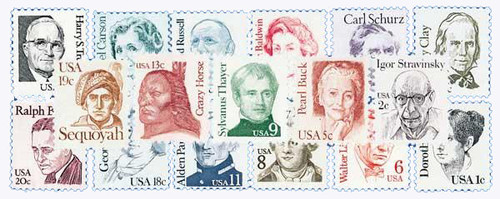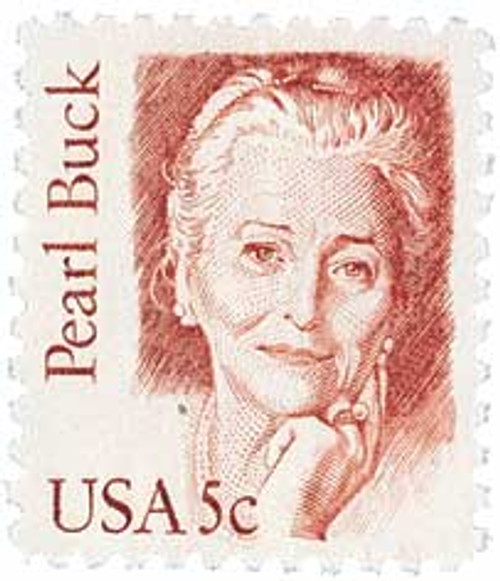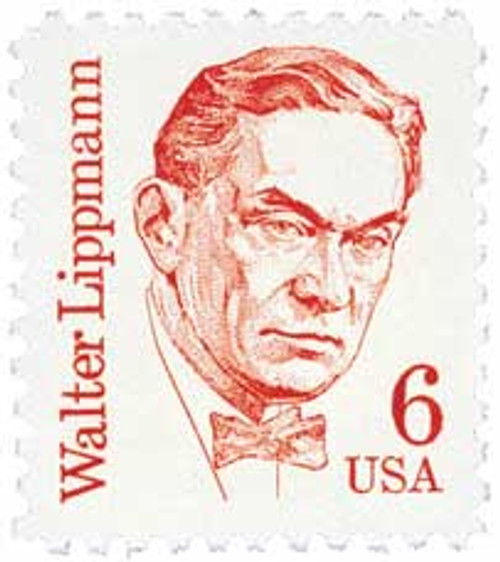
# 1867 - 1985 39c Great Americans: Grenville Clark
U.S. #1867
1985 39¢ Grenville Clark
Great Americans
- 21st stamp in the Great Americans Series
- Issued at Dartmouth College, which houses Clark’s personal papers
- Established the "Plattsburgh Plan" to train professional men to be officers in the Army
Stamp Category: Definitive
Series: Great Americans
Value: 39¢; first-class two-ounce rate or ½ ounce international airmail rate
First Day of Issue: March 20, 1985
First Day City: Hanover, New Hampshire
Quantity Issued: 268,850,000
Printed by: Bureau of Engraving & Printing
Printing Method: Engraved
Format: Panes of 100
Perforations: 11
Color: Rose lilac
Why the stamp was issued: On February 17, 1985, several postal rates were changed. One of the few that didn’t was the 17¢ rate for the second ounce of first-class mail. That 17¢ rate, plus the new 22¢ first-class rate, created a use for this 39¢ stamp. This stamp replaced the 1982 37¢ Robert Millikan stamp for that purpose. The stamp could also be used to pay the new ½-ounce international airmail rate to destinations including Columbia, Venezuela, Central America, the Caribbean, and other Pacific destinations.
About the stamp design: Roy Andersen, who also designed the Millikan stamp, created the portrait for this Grenville Clark stamp. Andersen based his portrait on several photos of Clark.
First Day City: The First Day ceremony for this stamp was held at the Spaulding Auditorium in the Hopkins Center at Dartmouth College, in Hanover, New Hampshire. Though he didn’t attend the school, it has a Grenville Clark Fund and houses his personal papers.
Unusual fact about this stamp: Error stamps have been discovered – vertical pairs that are imperforate horizontally and vertical pairs that are imperforate between. Horizontal imperforate stamps have a natural straight edge on the top and bottom outer edges, while imperforate between pairs have perforations on all four outer edges.
About the Great Americans Series: The Great Americans Series was created to replace the Americana Series. The new series would be characterized by a standard definitive size, simple design, and monochromatic colors.
This simple design included a portrait, “USA,” the denomination, the person’s name, and in some cases, their occupation or reason for recognition. The first stamp in the new series was issued on December 27, 1980. It honored Sequoyah and fulfilled the new international postcard rate that would go into effect in January 1981.
The Great Americans Series would honor a wider range of people than the previous Prominent Americans and Liberty Series. While those series mainly honored presidents and politicians, the Great Americans Series featured people from many fields and ethnicities. They were individuals who were leaders in education, the military, literature, the arts, and human and civil rights. Plus, while the previous series only honored a few women, the Great Americans featured 15 women. This was also the first definitive series to honor Native Americans, with five stamps.
The Bureau of Engraving and Printing (BEP) produced most of the stamps, but private firms printed some. Several stamps saw multiple printings. The result was many different varieties, with tagging being the key to understanding them. Though there were also differences in perforations, gum, paper, and ink color.
The final stamp in the series was issued on July 17, 1999, honoring Justin S. Morrill. Spanning 20 years, the Great Americans was the longest-running US definitive series. It was also the largest series of face-different stamps, with a total of 63.
Click here for all the individual stamps and click here for the complete series.
History the stamp represents: Grenville Clark was born on November 5, 1882, in New York City.
Clark was born into a wealthy family and attended Harvard Law School. There he befriended future Supreme Court Justice Felix Frankfurter, who would become a lifelong friend and unofficial uncle to Clark’s children.
After graduating from Harvard, Clark co-founded the law firm of Root, Clark, and Bird. They later merged with Buckner and Howland and their practice became one of the most prestigious law firms in the nation. While initially dealing with traditional litigation, they began taking cases in bankruptcy, reorganization, and New Deal regulations during the Depression. They also built up a corporate practice and eventually had 74 associates.
As World War I approached, Clark dedicated himself to preparing America for the conflict, serving as a major in the Adjutant General’s Department of the US Army. He also helped to establish the Citizens’ Military Training Camp in Plattsburgh, New York. This was part of his “Plattsburgh Plan,” a program that trained business and professional men to be officers in the Army. He and other prestigious businessmen used their own money to pay for food and uniforms for the training camps.
After the war, Clark led the American Bar Association and was one of the five fellows of the Harvard Corporation. He also founded the American Bar Association’s Civil Liberties Committee and helped draft the Economy Act of 1933, which sought to reduce the federal deficit.
From 1940-41, Clark served as the chairman of the National Emergency Committee for Selective Service. In that position he helped draft the Selective Service Act of 1940, the nation’s first peacetime conscription law. He also worked toward American military preparedness and was a confidential counsel to the secretary of War.
After the Second World War, Clark became an advocate for peace through international law. He and several others met in Dublin, New Hampshire for the Dublin Conference. They found the UN Charter to be insufficient and sought to turn the UN General Assembly into a world legislature. Their proposal stated that, “Such a government should be based upon a constitution under which all peoples and nations will participate upon a basis of balanced representation which will take account of natural and industrial resources and other factors as well as population. It cannot be based on treaties…in which the states… act and vote as states.” Additionally, it called for “limited but definite and adequate power for the prevention of war.”
Clark published his beliefs in his influential 1958 book, World Peace Through World Law. Clark was also involved in aiding minorities in their struggle for civil rights during the 1960s. He raised $80,000 bail for the famous “Freedom Riders,” and donated $500,000 to the National Association for the Advancement of Colored People.
Clark was nominated for the Nobel Peace Prize several times over the years, but was never awarded it. He died on January 13, 1967. Today, Clark’s work continues through a grant made to Dartmouth College in Hanover, New Hampshire. The Dartmouth College “Grenville Clark Fund” awards grants to organizations that promote world peace through world law. Dartmouth College also houses Clark’s personal papers.
U.S. #1867
1985 39¢ Grenville Clark
Great Americans
- 21st stamp in the Great Americans Series
- Issued at Dartmouth College, which houses Clark’s personal papers
- Established the "Plattsburgh Plan" to train professional men to be officers in the Army
Stamp Category: Definitive
Series: Great Americans
Value: 39¢; first-class two-ounce rate or ½ ounce international airmail rate
First Day of Issue: March 20, 1985
First Day City: Hanover, New Hampshire
Quantity Issued: 268,850,000
Printed by: Bureau of Engraving & Printing
Printing Method: Engraved
Format: Panes of 100
Perforations: 11
Color: Rose lilac
Why the stamp was issued: On February 17, 1985, several postal rates were changed. One of the few that didn’t was the 17¢ rate for the second ounce of first-class mail. That 17¢ rate, plus the new 22¢ first-class rate, created a use for this 39¢ stamp. This stamp replaced the 1982 37¢ Robert Millikan stamp for that purpose. The stamp could also be used to pay the new ½-ounce international airmail rate to destinations including Columbia, Venezuela, Central America, the Caribbean, and other Pacific destinations.
About the stamp design: Roy Andersen, who also designed the Millikan stamp, created the portrait for this Grenville Clark stamp. Andersen based his portrait on several photos of Clark.
First Day City: The First Day ceremony for this stamp was held at the Spaulding Auditorium in the Hopkins Center at Dartmouth College, in Hanover, New Hampshire. Though he didn’t attend the school, it has a Grenville Clark Fund and houses his personal papers.
Unusual fact about this stamp: Error stamps have been discovered – vertical pairs that are imperforate horizontally and vertical pairs that are imperforate between. Horizontal imperforate stamps have a natural straight edge on the top and bottom outer edges, while imperforate between pairs have perforations on all four outer edges.
About the Great Americans Series: The Great Americans Series was created to replace the Americana Series. The new series would be characterized by a standard definitive size, simple design, and monochromatic colors.
This simple design included a portrait, “USA,” the denomination, the person’s name, and in some cases, their occupation or reason for recognition. The first stamp in the new series was issued on December 27, 1980. It honored Sequoyah and fulfilled the new international postcard rate that would go into effect in January 1981.
The Great Americans Series would honor a wider range of people than the previous Prominent Americans and Liberty Series. While those series mainly honored presidents and politicians, the Great Americans Series featured people from many fields and ethnicities. They were individuals who were leaders in education, the military, literature, the arts, and human and civil rights. Plus, while the previous series only honored a few women, the Great Americans featured 15 women. This was also the first definitive series to honor Native Americans, with five stamps.
The Bureau of Engraving and Printing (BEP) produced most of the stamps, but private firms printed some. Several stamps saw multiple printings. The result was many different varieties, with tagging being the key to understanding them. Though there were also differences in perforations, gum, paper, and ink color.
The final stamp in the series was issued on July 17, 1999, honoring Justin S. Morrill. Spanning 20 years, the Great Americans was the longest-running US definitive series. It was also the largest series of face-different stamps, with a total of 63.
Click here for all the individual stamps and click here for the complete series.
History the stamp represents: Grenville Clark was born on November 5, 1882, in New York City.
Clark was born into a wealthy family and attended Harvard Law School. There he befriended future Supreme Court Justice Felix Frankfurter, who would become a lifelong friend and unofficial uncle to Clark’s children.
After graduating from Harvard, Clark co-founded the law firm of Root, Clark, and Bird. They later merged with Buckner and Howland and their practice became one of the most prestigious law firms in the nation. While initially dealing with traditional litigation, they began taking cases in bankruptcy, reorganization, and New Deal regulations during the Depression. They also built up a corporate practice and eventually had 74 associates.
As World War I approached, Clark dedicated himself to preparing America for the conflict, serving as a major in the Adjutant General’s Department of the US Army. He also helped to establish the Citizens’ Military Training Camp in Plattsburgh, New York. This was part of his “Plattsburgh Plan,” a program that trained business and professional men to be officers in the Army. He and other prestigious businessmen used their own money to pay for food and uniforms for the training camps.
After the war, Clark led the American Bar Association and was one of the five fellows of the Harvard Corporation. He also founded the American Bar Association’s Civil Liberties Committee and helped draft the Economy Act of 1933, which sought to reduce the federal deficit.
From 1940-41, Clark served as the chairman of the National Emergency Committee for Selective Service. In that position he helped draft the Selective Service Act of 1940, the nation’s first peacetime conscription law. He also worked toward American military preparedness and was a confidential counsel to the secretary of War.
After the Second World War, Clark became an advocate for peace through international law. He and several others met in Dublin, New Hampshire for the Dublin Conference. They found the UN Charter to be insufficient and sought to turn the UN General Assembly into a world legislature. Their proposal stated that, “Such a government should be based upon a constitution under which all peoples and nations will participate upon a basis of balanced representation which will take account of natural and industrial resources and other factors as well as population. It cannot be based on treaties…in which the states… act and vote as states.” Additionally, it called for “limited but definite and adequate power for the prevention of war.”
Clark published his beliefs in his influential 1958 book, World Peace Through World Law. Clark was also involved in aiding minorities in their struggle for civil rights during the 1960s. He raised $80,000 bail for the famous “Freedom Riders,” and donated $500,000 to the National Association for the Advancement of Colored People.
Clark was nominated for the Nobel Peace Prize several times over the years, but was never awarded it. He died on January 13, 1967. Today, Clark’s work continues through a grant made to Dartmouth College in Hanover, New Hampshire. The Dartmouth College “Grenville Clark Fund” awards grants to organizations that promote world peace through world law. Dartmouth College also houses Clark’s personal papers.




















